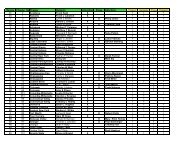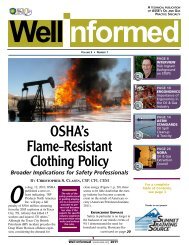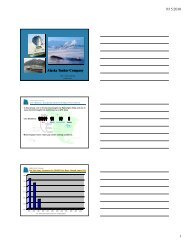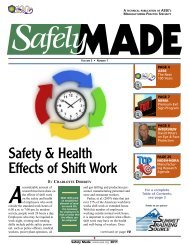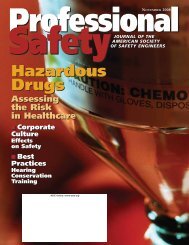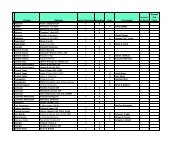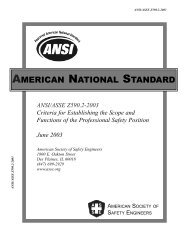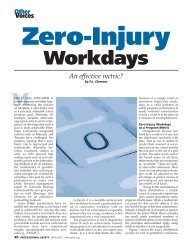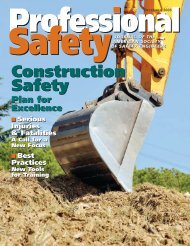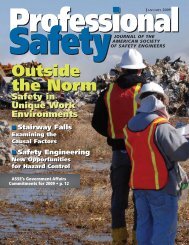Safety 2008 - ASSE - American Society of Safety Engineers
Safety 2008 - ASSE - American Society of Safety Engineers
Safety 2008 - ASSE - American Society of Safety Engineers
Create successful ePaper yourself
Turn your PDF publications into a flip-book with our unique Google optimized e-Paper software.
Distressed by miners’ injuriescaused by the methods <strong>of</strong> setting<strong>of</strong>f explosives to break uplarge amounts <strong>of</strong> rock, Bickforddesigned a fuse made fromstrands <strong>of</strong> rope wound arounda core <strong>of</strong> gunpowder, then varnished.His safety fuse hassaved hundreds <strong>of</strong> lives andprevented many serious injuries.Lukens was determinednot to sit onthe sidelines. She wasactively involve withher family’s business.Because <strong>of</strong> the injuriesthat were occurring inthe iron mills, sheworked to improvesafety in iron works.After witnessing a railcrossing accident, Rigginhad the idea <strong>of</strong> preventingothers from the same fate.This led her to invent thefirst apparatus to preventanimals, wagons andsome cars from crossingthe tracks as trainsapproached.Costondevelopeda maritimenavigationsystem using pyrotechnics.These burning flares helped theU.S. Navy and the navies <strong>of</strong>many European countries tocommunicate with and rescueshipwreck victims.In 1885, Starley made history when he produced theRover <strong>Safety</strong> Bicycle—a rear-wheel-drive, chain-drivencycle with two similar-sized wheels, making itmore stable than the previous high-wheeled designs.Starley’s Rover is usually described by historians asthe first recognizably modern bicycle. This new“safety bicycle” was an immediate success and wasexported around the world.On May 24, 1883, the BrooklynBridge opened to traffic. Thosewho were there to witness its constructionsaw the familiar face <strong>of</strong>Emily Warren, the chief engineerfrom 1872 to 1883. She supervisedthe day-to-day construction afterher husband became bedridden.Born a free man, Martinreceived a patent on March26, 1872, for the first fireextinguishing suppressingapparatus, which later wasremodeled as a portableextinguisher.Woods made traincommunicationbetween the stationand other trains possibleby inventingthe “SynchronousMultiplex RailwayTelegraph.” He isalso responsible for inventing the automaticair brakes for trains and the “thirdrail” concept, all being used in mass-transitrail systems today.Finlay was a Cuban physicianwho discovered the cure for yellowfever. His theory that yellowfever came from mosquitoessaved million <strong>of</strong> lives. The WalterReed commission <strong>of</strong> 1900 inauguratedexperiments that conclusivelyproved his theory to be true.Morgan’s safety helmet was used bythe allied forces in World War I andserved as the prototype for the modern-dayrespirator. He also patentedthe directional traffic signal, laterchanged to three colors, which nowdirects traffic on mostroads/highways around the world.Before Gustaf Pasch invented thesafety match in 1884, matcheswere very dangerous because theywere made from yellow phosphorus,a poisonous substance. Thesafety match, which used red phosphorus onthe striking surface, not the match itself,would only ignite when struck on the box’sstriking surface. A decade later, JohanLundstrom improved and perfected thismatch, increasing its safe use and popularity.Apgar made it safe for newbornbabies in the first criticalminutes <strong>of</strong> their lives tobe evaluated for birth defectsby developing the ApgarScore. This was the first standardizedmethod for evaluatinga newborn’s transitionto life outside the womb.Ochoa’s expertise in optics and computerhardware had the potential toDuring Mineta’s first 4 years asSecretary <strong>of</strong> Transportation, the U.S.improve not only the gathering <strong>of</strong> dataachieved the lowest vehicle fatalitybut also the assessing <strong>of</strong> the integrityrate, the highest safety belt usage rateAppointed by President and safety <strong>of</strong>and the lowest rail fatality level everRonald Reagan in 1983, Dole equipment atrecorded. He also oversaw the safestbecame the first women ever NASA. In 1990,3-year period in aviation history.chosen as U.S. Secretary <strong>of</strong> NASA acceptedMineta also helpedTransportation. One <strong>of</strong> the her into its astronauttraining pro-to persuade all U.S.most famous accomplishmentsduring her tenure gram, and in Julystates to set a bloodalcohol rate <strong>of</strong>was the mandatory implementation<strong>of</strong> the third brake became an <strong>of</strong>ficial1991, Ochoa0.08%, a level thathas proven to belight on all passenger cars. U.S. astronaut.effective in preventingautomobilecrashes andBath became the firstimproving safety.African-<strong>American</strong> femalephysician to receive a patentfor a medical invention. HerChao was the first Asianinvention,the “Laserphaco<strong>American</strong> woman appointed toProbe” (forerunner to Lasik)a presidential cabinet in U.S. history.Her dedication to promot-transformed eye surgery. Itused a laser device thating safety and health at that U.S.safely and quickly removedDepartment <strong>of</strong> Labor set the barcataracts from patients’ eyes and gave them thefor future leaders.ability to see again.1810 1820 1830 1840 1850 61860 1870 1880 1890 1910 1920 1930 1940 1950 1960 1970 1980 19902010At GE, Thompson was considered a “scientificsage,” and he helped establish atradition <strong>of</strong> regular product improvementand scientific research that led tothe creation <strong>of</strong> GE’s first research laboratoryin 1900. Before the turn <strong>of</strong> the century,he also developed equipment for GEleading to the production <strong>of</strong> X-rays, anddemonstrated the use <strong>of</strong> X-ray picturesfor diagnosing bone fractures and findingforeign objects in the body.In 1958, Chappellejoined the ResearchSlater wasInstitute for Advancedappointed U.S.Studies in Baltimore, aElion is a recipient <strong>of</strong>Secretary <strong>of</strong> Transportationin 1997.division <strong>of</strong> the Martinthe 1988 Nobel PrizeMarietta Corporationfor Physiology orDuring his term,that was famous forMedicine. She is creditedwith the co-repaired thou-the departmentdesigning airplanesand spacecraft. There, Chappelle discoveredthat even one-celled plantscessful drugs for the treatment <strong>of</strong>try’s bridges, improving them to theirdevelopment <strong>of</strong> two <strong>of</strong> the first sucsands<strong>of</strong> the coun-such as algae, which are lightweightleukemia, as well as an agent that best condition in years; acted aggressivelyto improve the safety <strong>of</strong> theand can be transported easily, canhas helped doctors prevent the rejection<strong>of</strong> kidney transplants. Elion also U.S. rail system; averted a strike byconvert carbon dioxide to oxygen. Thisdiscovery helped to create a safeplayed a major role in the development<strong>of</strong> the first selective antiviral all <strong>American</strong>s to buckle their seatbelts.Amtrak; and initiated a program to getoxygen supply for astronauts.agent against herpes virus infections.Volvo’s first safety engineer,Bohlin invented the threepointsafety belt, a standard inHispanic and first woman toNovello became the firstthe modern automobile. Earlybe appointed U.S. Surgeontests showed that the belt wasGeneral. During her tenure,effective in restraining theshe played an important rolebody in high-speed crashesin launching the “Healthyand in preventing ejection. The National HighwayChildren Ready to LearnTraffic <strong>Safety</strong> Administration estimates that in theInitiative.” She also worked with other organizationsto promote immunization <strong>of</strong> children.U.S., the seatbelt saves more than 4,000 lives andprevents more than 100,000 injuries a year.Face toFaceGreaterunderstandingleads togreater trust,which leadsto greaterappreciation<strong>of</strong> others.William Bickford - 1800RebeccaLukens - 1825<strong>ASSE</strong> . . .DrawingStrengthThroughDiversityMary Riggin - 1862MarthaCosten -1859Emily Warren - 1883John Kemp Starley - 1885Thomas Martin - 1872<strong>ASSE</strong>’s DiversityCommittee developeda “Diversity in<strong>Safety</strong>” poster lastyear. To request acopy <strong>of</strong> the poster,contact <strong>ASSE</strong>’sGeri Golonka atggolonka@asse.org.Adding Diversity Awarenessto Your Leadership Skill SetDiversity in <strong>Safety</strong>Throughout the DecadesGranvilleWoods - 1884The originalsafety pioneershad vision and madelife safer for others. Theirinventions in maritime safety, railand traffic safety, chemical and electricalsafety, communications and health greatlyimproved how we work and live today.They were innovators and inspirations—and theymade a difference. You can, too.Carlos Juan Finlay - 1887Elihu Thompson - 1890Gustaf ErikPasch - 1884Johan EdvardLundstrom - 1885Garrett A. Morgan - 1912Virginia Apgar - 1952Patricia Bath - 1988EmmettChappelle - 1958Nils Bohlin - 1958Elizabeth Dole - 1983Ellen Ochoa - 1991Gertrude Elion -1980Antonia Novello - 1990Norman Mineta - 2001Elaine Chao - 20011800 1900 2000To effectively manage in today’s workplace,leaders must understand that diversity hasmany facets and is not limited to gender orrace. To ensure safety in the workplace and toimprove the quality <strong>of</strong> life in all <strong>of</strong> its aspects,SH&E pr<strong>of</strong>essionals must understand and embracediversity, and respect differences.<strong>ASSE</strong> is committed to supporting diversity withinthe <strong>Society</strong>. To that end, <strong>ASSE</strong> formed theDiversity Committee. The committee’s goal is toprovide inclusion without regard to race, ethnicity,religion, personal beliefs, age, gender, sexual orientation,nationality, or physical challenges by providingadvice and guidance to the <strong>Society</strong> to:•encourage an inclusive and diverse membership,leadership and staff;•promote a culture <strong>of</strong> inclusion and cooperation;•address diversity-related issues for the SH&Epr<strong>of</strong>essional, workforce and community.Today’s leadersmust understandculturalnorms and traditions,disabilities,religioustraditions andpractices, andthe influencehistory has hadin shaping generations.In thisinterview,which is basedon a presentationat and proceedingspaper from <strong>ASSE</strong>’s <strong>Safety</strong> <strong>2008</strong> conference,members <strong>of</strong> the Diversity Committee and <strong>ASSE</strong>member Ashok Garlapati share insights and personalexperiences relating to diversity.RodneySlater - 1997AMERICAN SOCIETY OF SAFETY ENGINEERS1800 E. Oakton St. • Des Plaines, IL 60018-2187 • (847) 699-2929 • www.asse.orgPS: How do you define diversity?Jamal AbuSneineh (JA): Diversity is the presence<strong>of</strong> a wide range <strong>of</strong> variation in the qualities orattributes <strong>of</strong> cultures, societies, communities, companiesand workgroups. It is the state <strong>of</strong> being differentor diverse. Diversity is used to describe people andpopulations. It encompasses such things as age, gender,race, ethnicity, ability, and religion, as well aseducation, pr<strong>of</strong>essional background and maritaland/or parental status. It carries with it an array <strong>of</strong>subject matter and connotations. It has also beendefined as the full use <strong>of</strong> human resource potential.Diversity is understanding, respecting and valuingdifferences while translating commonalities towardeffectively achieving a common objective or goal.Ashok Garlapati (AG): If you look into thedictionary, it provides a definition <strong>of</strong> mixture, varieties,range, assortment, etc. Workplace diversityrefers to the variety <strong>of</strong> differences between peoplein an organization. That sounds simple, but diversityencompasses race, gender, ethnic group, age,personality, cognitive style, tenure, organizationalfunction, education, background and more.Diversity involves not only how people perceivethemselves, but how they perceive others. Those perceptionsaffect their interactions. For a wide assortment<strong>of</strong> employees to function effectively as anorganization, human resource pr<strong>of</strong>essionals need todeal effectively with issues such as communication,adaptability and change. Diversity will increase significantlyin the coming years. Successful organizationsrecognize the need for immediate action andare ready and willing to spend resources on managingdiversity in the workplace now.Rixio Medina (RM): Diversity is the acceptanceand inclusion <strong>of</strong> people <strong>of</strong> different gender, race,ethnicity, age, religion, language, nationality, workstyle and experience, education, culture, organizationfunction, approach to problem solving, physicalappearance, personality type, liberal or conservativethinking and socioeconomic status, using thestrength <strong>of</strong> their differences to improve the group’soutput while working toward a common goal.Terrie Norris (TN): Growing up I did notknow about diversity—I just knew that I was differentbecause <strong>of</strong> the way I was treated. My fatherwas in the military, which meant frequent relocations,so I was always that new kid who “wasn’tfrom around here.” I spoke differently. I dresseddifferently. I did not have the shared childhoodmemories—I was an outsider.Diversity goes beyond the most frequently recognizedrace and gender. It also involves geography,language, accent, age, life experiences, education,heritage, disabilities and religion.PS: How does diversity affect communication?JA: It affects communication in so many waysand <strong>of</strong>ten leads to misunderstandings. Every one <strong>of</strong>us comes from a different background with differentexperiences that lead to different results.Because <strong>of</strong> this, each <strong>of</strong> us brings something differentto the table. We each bring a set <strong>of</strong> skills, knowledgeand experience that makes up the diversity <strong>of</strong>us all. It’s in this diversity that we can flourish as agroup and enhance our environment.Communication is the most important part <strong>of</strong> success<strong>of</strong> any group or organization.AG: Every organization takes full advantage <strong>of</strong>diversity. In this process, they will face many challengesparticularly related to communication.Perceptual, cultural and language barriers need tobe overcome for diversity programs to succeed.Face to Face continued on page 48www.asse.org AUGUST <strong>2008</strong> PROFESSIONAL SAFETY 47



